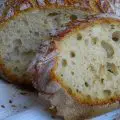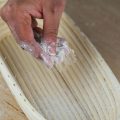One of the essential stages of bread baking is dough mixing. While there are many methods of kneading dough, some are deemed a little better than others. Take the Rubaud method, for instance. It is considered the best way of mixing sourdough, because it works exceptionally well with high-hydration doughs. You’ll understand why this technique works, as you read on!

Table of Contents
- What is the Rubaud Method of Mixing?
- Rubaud Method of Hand Kneading
- Why Knead Dough?
- The Stages of Kneading Dough
- How Long Should I Knead Bread Dough For?
- Rubaud Mixing
- FAQs
What is the Rubaud Method of Mixing?
The Rubaud method is a popular technique of hand-mixing dough. The mixing process helps develop a strong gluten structure. The Rubaud method involves gently lifting and pulling the dough in a bowl, almost like a diving arm mixer.
Building gluten strength is essential, as this enables you to handle the dough more gently during bulk fermentation. Much like every mixing method, the “rest” time is just as important as the mixing time. Hand mix for 5 minutes, then let the dough rest for 5 and repeat. Your dough should become firmer after each rest.
Rubaud Method of Hand Kneading
This kneading method was created by the rather remarkable Gerard Rubaud. This method works best when kneading highly hydrated doughs. It involves using wet hands to move the dough quickly, whilst incorporating lots of oxygen for strength. This method is especially great for doughs that require a pre-fermented levain such as a sourdough starter.
Rubaud Mixing Method
- First, wet your hands with water.
- Place your dominant hand in a cupping shape, and hold the bowl with the other hand.
- Use your cupped hand to scoop the dough up to stretch it.
- Repeat the stretches using a circular motion.
- After 15-20 stretches, release the dough and repeat on a different area.
Why Knead Dough?
Kneading is an important stage in sourdough bread baking.
The purpose of kneading dough is as follows:
- To evenly distribute the ingredients
- To hydrate the flour with water
- To develop a good gluten structure
- To incorporate oxygen into the dough
The Stages of Kneading Dough
There are three key stages of kneading dough: incorporation, intermediate, and fast. Each stage provides a different purpose for the dough’s functionality.
Incorporation
This is known as the initial mixing where the ingredients are bought together to form a rough dough. For smaller doughs, this stage can last a couple of minutes, whilst larger or stiff doughs may take up to 4 minutes.
Slow Mixing
The slow mixing or intermediate stage takes place immediately after incorporation. This is where you’ll require long, and slow movements to encourage the flour to absorb the liquid, as well as hydrate the gluten and starches. This is essential for gluten development. As the gluten hydrates, the gluten strands become longer and the dough can stretch further, all without the need for excessive oxygen.
Fast kneading
This type of hand kneading technique is quite aggressive. Quick, rapid movements stretch the gluten whilst incorporating lots of oxygen. This results in a firmer dough.

How Long Should I Knead Bread Dough For?
Typically, bread dough should be mixed for at least 10-15 minutes. This means 1-2 minutes of incorporation, 5-7 minutes of slow mixing, followed by 5-8 minutes of fast kneading.
You can reduce the time by including an autolyze, or by resting the dough in the refrigerator between each kneading stage.
Rubaud Mixing
If you’re dealing with a very wet dough, then the best way to knead it is through the Rubaud mixing method. With great bread comes great practice, and lots of practice promises perfection!
FAQs
What Mixing Method is Used For Sourdough?
The Rubaud mixing method is often used for sourdough. Essentially, the Rubaud method is a mixing style that helps thoroughly incorporate the final dough mix.
What Are The 3 Methods of Mixing Dough?
There are 3 different methods for mixing dough ingredients: the straight dough method, the modified straight dough method, and the sponge method.
Can You Stretch and Fold Sourdough too Much?
You can overfold the dough in an attempt to gently build up the gluten network. Although once the gluten network has formed, over-handling the dough can break this network down.
What is Stretch and Fold in Bread Making?
The stretch and fold method involves a series of gentle stretches and firm folds to help strengthen the gluten network within the dough.





![How To Stretch And Fold Sourdough [A Detailed Guide] 7 How to stretch and fold sourdough [a detailed guide]](https://www.mydailysourdoughbread.com/wp-content/uploads/2023/06/How-To-Stretch-And-Fold-Sourdough-120x120.jpg)
